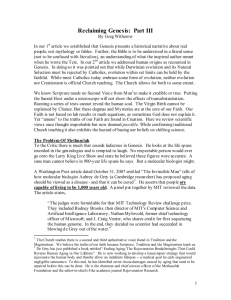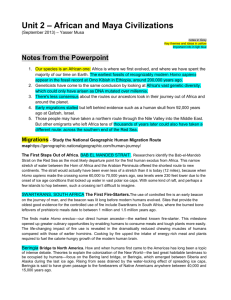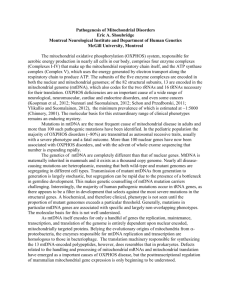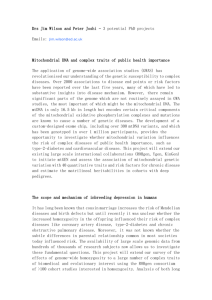DOC
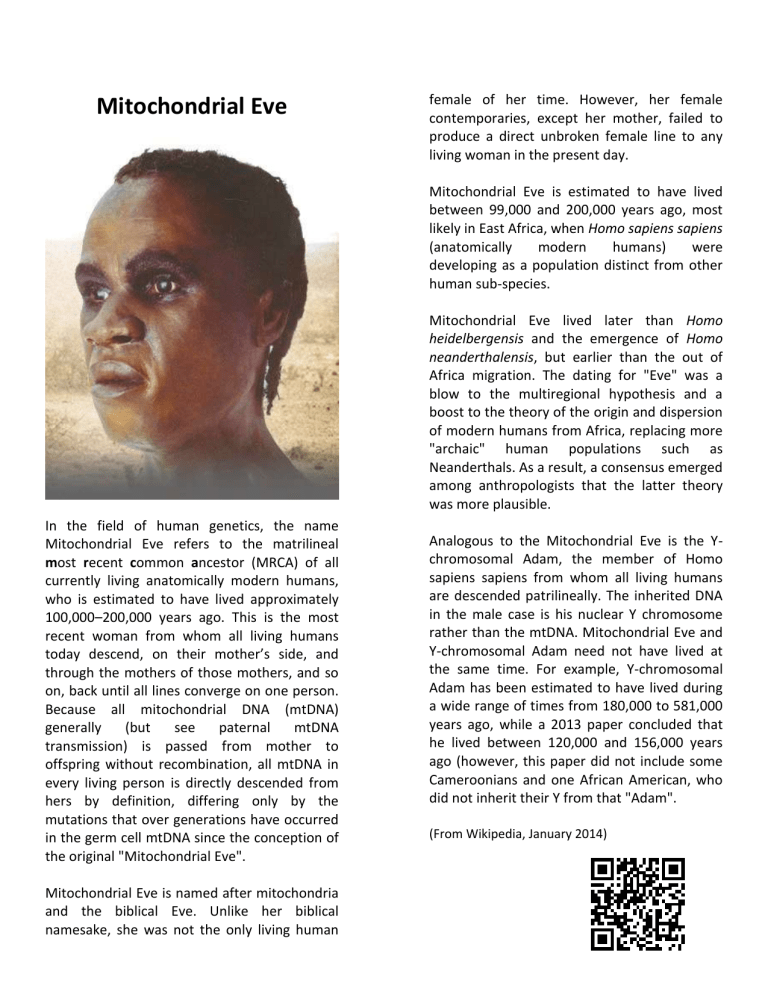
Mitochondrial Eve
In the field of human genetics, the name
Mitochondrial Eve refers to the matrilineal
most recent common ancestor (MRCA) of all currently living anatomically modern humans, who is estimated to have lived approximately
100,000–200,000 years ago. This is the most recent woman from whom all living humans today descend, on their mother’s side, and through the mothers of those mothers, and so on, back until all lines converge on one person.
Because all mitochondrial DNA (mtDNA) generally (but see paternal mtDNA transmission) is passed from mother to offspring without recombination, all mtDNA in every living person is directly descended from hers by definition, differing only by the mutations that over generations have occurred in the germ cell mtDNA since the conception of the original "Mitochondrial Eve".
Mitochondrial Eve is named after mitochondria and the biblical Eve. Unlike her biblical namesake, she was not the only living human female of her time. However, her female contemporaries, except her mother, failed to produce a direct unbroken female line to any living woman in the present day.
Mitochondrial Eve is estimated to have lived between 99,000 and 200,000 years ago, most likely in East Africa, when Homo sapiens sapiens
(anatomically modern humans) were developing as a population distinct from other human sub-species.
Mitochondrial Eve lived later than Homo
heidelbergensis and the emergence of Homo
neanderthalensis, but earlier than the out of
Africa migration. The dating for "Eve" was a blow to the multiregional hypothesis and a boost to the theory of the origin and dispersion of modern humans from Africa, replacing more
"archaic" human populations such as
Neanderthals. As a result, a consensus emerged among anthropologists that the latter theory was more plausible.
Analogous to the Mitochondrial Eve is the Ychromosomal Adam, the member of Homo sapiens sapiens from whom all living humans are descended patrilineally. The inherited DNA in the male case is his nuclear Y chromosome rather than the mtDNA. Mitochondrial Eve and
Y-chromosomal Adam need not have lived at the same time. For example, Y-chromosomal
Adam has been estimated to have lived during a wide range of times from 180,000 to 581,000 years ago, while a 2013 paper concluded that he lived between 120,000 and 156,000 years ago (however, this paper did not include some
Cameroonians and one African American, who did not inherit their Y from that "Adam".
(From Wikipedia, January 2014)
Mitochondrial Eve
In the field of human genetics, the name
Mitochondrial Eve refers to the matrilineal
most recent common ancestor (MRCA) of all currently living anatomically modern humans, who is estimated to have lived approximately
100,000–200,000 years ago. This is the most recent woman from whom all living humans today descend, on their mother’s side, and through the mothers of those mothers, and so on, back until all lines converge on one person.
Because all mitochondrial DNA (mtDNA) generally (but see paternal mtDNA transmission) is passed from mother to offspring without recombination, all mtDNA in every living person is directly descended from hers by definition, differing only by the mutations that over generations have occurred in the germ cell mtDNA since the conception of the original "Mitochondrial Eve".
Mitochondrial Eve is named after mitochondria and the biblical Eve. Unlike her biblical namesake, she was not the only living human female of her time. However, her female contemporaries, except her mother, failed to produce a direct unbroken female line to any living woman in the present day.
Mitochondrial Eve is estimated to have lived between 99,000 and 200,000 years ago, most likely in East Africa, when Homo sapiens sapiens
(anatomically modern humans) were developing as a population distinct from other human sub-species.
Mitochondrial Eve lived later than Homo
heidelbergensis and the emergence of Homo
neanderthalensis, but earlier than the out of
Africa migration. The dating for "Eve" was a blow to the multiregional hypothesis and a boost to the theory of the origin and dispersion of modern humans from Africa, replacing more
"archaic" human populations such as
Neanderthals. As a result, a consensus emerged among anthropologists that the latter theory was more plausible.
Analogous to the Mitochondrial Eve is the Ychromosomal Adam, the member of Homo sapiens sapiens from whom all living humans are descended patrilineally. The inherited DNA in the male case is his nuclear Y chromosome rather than the mtDNA. Mitochondrial Eve and
Y-chromosomal Adam need not have lived at the same time. For example, Y-chromosomal
Adam has been estimated to have lived during a wide range of times from 180,000 to 581,000 years ago, while a 2013 paper concluded that he lived between 120,000 and 156,000 years ago (however, this paper did not include some
Cameroonians and one African American, who did not inherit their Y from that "Adam".
(From Wikipedia, January 2014)

